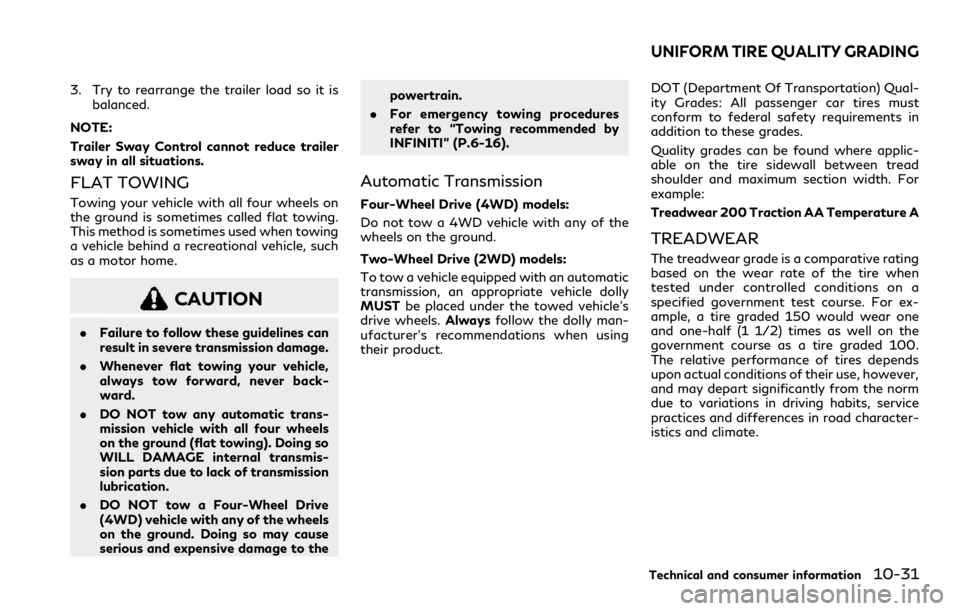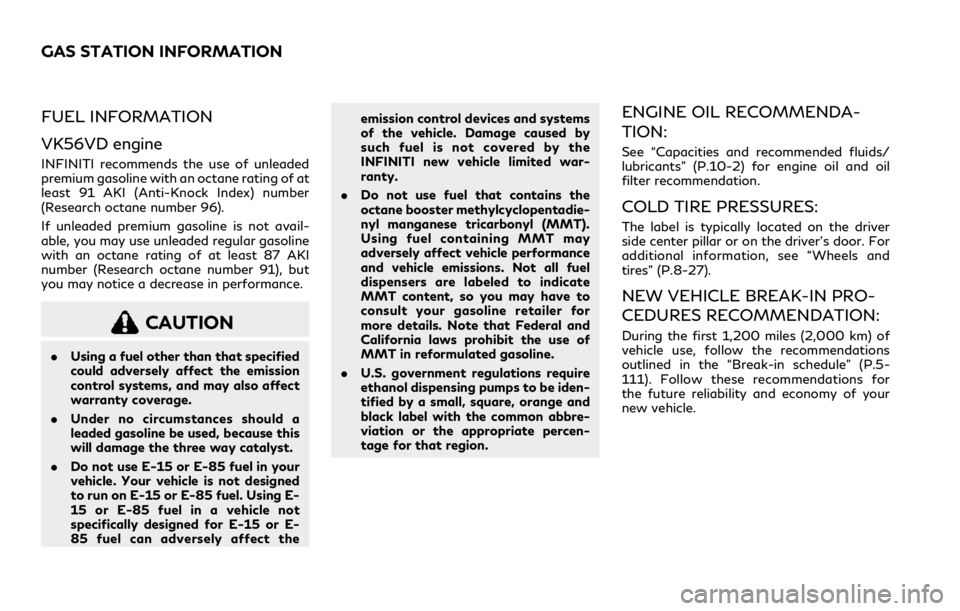tires INFINITI QX80 2021 Service Manual
[x] Cancel search | Manufacturer: INFINITI, Model Year: 2021, Model line: QX80, Model: INFINITI QX80 2021Pages: 529, PDF Size: 2.05 MB
Page 490 of 529
![INFINITI QX80 2021 Service Manual WHEELS AND TIRES
Road wheel
TypeSizeOffset in (mm)
Conventional 20 × 8J
1.18 (30)
22 × 8J
Spare 20 × 8J
18 × 8J
Tire
Type
SizePressure PSI (kPa) [Cold]
Conventional P275/60R20 114H
35 (240)
P275/5 INFINITI QX80 2021 Service Manual WHEELS AND TIRES
Road wheel
TypeSizeOffset in (mm)
Conventional 20 × 8J
1.18 (30)
22 × 8J
Spare 20 × 8J
18 × 8J
Tire
Type
SizePressure PSI (kPa) [Cold]
Conventional P275/60R20 114H
35 (240)
P275/5](/img/42/35183/w960_35183-489.png)
WHEELS AND TIRES
Road wheel
TypeSizeOffset in (mm)
Conventional 20 × 8J
1.18 (30)
22 × 8J
Spare 20 × 8J
18 × 8J
Tire
Type
SizePressure PSI (kPa) [Cold]
Conventional P275/60R20 114H
35 (240)
P275/50R22 111H
Spare 275/60R20 115M
265/70R18 116M
51 (350)
Technical and consumer information10-9
Page 498 of 529

VEHICLE LOAD CAPACITY
Do not exceed the load limit of your
vehicle shown as “The combined
weight of occupants and cargo” on
the Tire and Loading Information
label. Do not exceed the number of
occupants shown as “Seating Capa-
city” on the Tire and Loading Infor-
mation label.
To get “the combined weight of
occupants and cargo”, add the weight
of all occupants, then add the total
luggage weight. Examples are shown
in the illustration.
Steps for determining correct load
limit
1. Locate the statement “The com-bined weight of occupants and
cargo should never exceed XXX
kg or XXX lbs” on your vehicle’s
placard.
2. Determine the combined weight of the driver and passengers that will
be riding in your vehicle.
3. Subtract the combined weight of the driver and passengers from
XXX kg or XXX lbs.
4. The resulting figure equals the available amount of cargo and
luggage load capacity. For exam-
ple, if the XXX amount equals
1400 lbs. and there will be five
150 lb. passengers in your vehicle,
the amount of available cargo and
luggage load capacity is 650 lbs.
(1400 − 750 (5 x 150) = 650 lbs) or
(640 − 340 (5 x 70) = 300 kg.)
5. Determine the combined weight of luggage and cargo being loaded on
the vehicle. That weight may not
safely exceed the available cargo
and luggage load capacity calcu-
lated in Step 4.
6. If your vehicle will be towing a trailer, load from your trailer will
be transferred to your vehicle.
Consult this manual to determine
how this reduces the available
cargo and luggage load capacity
of your vehicle.
Before driving a loaded vehicle, con-
firm that you do not exceed the Gross Vehicle Weight Rating (GVWR) or the
Gross Axle Weight Rating (GAWR)
for your vehicle. (See “Measurement
of weights” (P.10-19).)
Also check tires for proper inflation
pressures. See the Tire and Loading
Information label.
Technical and consumer information10-17
Page 507 of 529

10-26Technical and consumer information
measured reference height when loaded,
the vehicle may handle unpredictably
which could cause a loss of vehicle
control and cause serious personal injury
or property damage.
Sway control device
Sudden maneuvers, wind gusts and buffet-
ing caused by other vehicles can affect
trailer handling. Sway control devices may
be used to help control these affects. If you
choose to use one, contact a reputable
trailer hitch supplier to make sure the sway
control device will work with the vehicle,
hitch, trailer and the trailer’s brake system.
Follow the instructions provided by the
manufacturer for installing and using the
sway control device.
Class I hitch
Class I trailer hitch equipment (receiver, ball
mount and hitch ball) can be used to tow
trailers of a maximum weight of 2,000 lb
(907 kg).
Class II hitch
Class II trailer hitch equipment (receiver, ball
mount and hitch ball) can be used to tow
trailers of a maximum weight of 3,500 lb
(1,588 kg).
Class III hitch
Class III trailer hitch equipment (receiver, ball
mount and hitch ball) can be used to tow
trailers of a maximum weight of 5,000 lb
(2,267 kg).
Class IV hitch
Class IV trailer hitch equipment (receiver, ball
mount and hitch ball) can be used to tow
trailers of a maximum weight of 10,000 lb
(4,545 kg). A weight distributing hitch
should be used to tow trailers that weigh
over 5,000 lb (2,267 kg).
Your vehicle may be equipped with Class IV
trailer hitch equipment that has a 10,000 lb
(4,545 kg) maximum weight rating, but your
vehicle is only capable of towing the max-
imum trailer weights shown in the “Towing
Load/Specification” chart earlier in this
section.
CAUTION
.Do not use axle-mounted hitches.
. Do not modify the vehicle exhaust
system, brake system, etc.
. Do not attach any additional hitches
to your vehicle because a hitch is
already mounted to your vehicle frame.
Tire pressures
.
When towing a trailer, inflate the
vehicle tires to the recommended
cold tire pressure indicated on the
Tire and Loading Information la-
bel.
. Trailer tire condition, size, load
rating and proper inflation pres-
sure should be in accordance with
the trailer and tire manufacturers’
specifications.
Safety chains
Always use a suitable chain between your
vehicle and the trailer. The safety chains
should be crossed and should be attached to
the hitch, not to the vehicle bumper or axle.
Be sure to leave enough slack in the chains to
permit turning corners.
Page 512 of 529

3. Try to rearrange the trailer load so it isbalanced.
NOTE:
Trailer Sway Control cannot reduce trailer
sway in all situations.
FLAT TOWING
Towing your vehicle with all four wheels on
the ground is sometimes called flat towing.
This method is sometimes used when towing
a vehicle behind a recreational vehicle, such
as a motor home.
CAUTION
. Failure to follow these guidelines can
result in severe transmission damage.
. Whenever flat towing your vehicle,
always tow forward, never back-
ward.
. DO NOT tow any automatic trans-
mission vehicle with all four wheels
on the ground (flat towing). Doing so
WILL DAMAGE internal transmis-
sion parts due to lack of transmission
lubrication.
. DO NOT tow a Four-Wheel Drive
(4WD) vehicle with any of the wheels
on the ground. Doing so may cause
serious and expensive damage to the powertrain.
. For emergency towing procedures
refer to “Towing recommended by
INFINITI” (P.6-16).
Automatic Transmission
Four-Wheel Drive (4WD) models:
Do not tow a 4WD vehicle with any of the
wheels on the ground.
Two-Wheel Drive (2WD) models:
To tow a vehicle equipped with an automatic
transmission, an appropriate vehicle dolly
MUST be placed under the towed vehicle’s
drive wheels. Alwaysfollow the dolly man-
ufacturer’s recommendations when using
their product. DOT (Department Of Transportation) Qual-
ity Grades: All passenger car tires must
conform to federal safety requirements in
addition to these grades.
Quality grades can be found where applic-
able on the tire sidewall between tread
shoulder and maximum section width. For
example:
Treadwear 200 Traction AA Temperature A
TREADWEAR
The treadwear grade is a comparative rating
based on the wear rate of the tire when
tested under controlled conditions on a
specified government test course. For ex-
ample, a tire graded 150 would wear one
and one-half (1 1/2) times as well on the
government course as a tire graded 100.
The relative performance of tires depends
upon actual conditions of their use, however,
and may depart significantly from the norm
due to variations in driving habits, service
practices and differences in road character-
istics and climate.
Technical and consumer information10-31
UNIFORM TIRE QUALITY GRADING
Page 513 of 529

10-32Technical and consumer information
TRACTION AA, A, B AND C
The traction grades, from highest to lowest,
are AA, A, B and C. Those grades represent
the tire’s ability to stop on wet pavement as
measured under controlled conditions on
specified government test surfaces of as-
phalt and concrete. A tire marked C may
have poor traction performance.
WARNING
The traction grade assigned to this tire is
based on straight-ahead braking trac-
tion tests, and does not include accel-
eration, cornering, hydroplaning, or peak
traction characteristics.
TEMPERATURE A, B AND C
The temperature grades A (the highest), B,
and C, representing the tire’s resistance to
the generation of heat and its ability to
dissipate heat when tested under controlled
conditions on a specified indoor laboratory
test wheel. Sustained high temperature can
cause the material of the tire to degenerate
and reduce tire life, and excessive tempera-
ture can lead to sudden tire failure. The
grade C corresponds to a level of perfor-
mance which all passenger car tires must
meet under the Federal Motor VehicleSafety Standard No. 109. Grades B and A
represent higher levels of performance on
the laboratory test wheel than the minimum
required by law.
WARNING
The temperature grade for this tire is
established for a tire that is properly
inflated and not overloaded. Excessive
speed, under-inflation, or excessive
loading, either separately or in combina-
tion, can cause heat build-up and possi-
ble tire failure.
Your INFINITI is covered by the following
emission warranties.
For USA:
.
Emission Defects Warranty
. Emissions Performance Warranty
Details of these warranties may be found
with other vehicle warranties in your War-
ranty Information Booklet that comes with
your INFINITI. If you did not receive a
Warranty Information Booklet, or it has
become lost, you may obtain a replacement
by writing to:
. INFINITI Division
Nissan North America, Inc.
Consumer Affairs Department
P.O. Box 685003
Franklin, TN 37068-5003
For Canada:
Emission Control System Warranty
Details of these warranties may be found
with other vehicle warranties in your War-
ranty and Roadside Assistance Information
that comes with your INFINITI. If you did not
receive a Warranty and Roadside Assistance
Information, or it has become lost, you may
obtain a replacement by writing to:
. Nissan Canada Inc.
5290 Orbitor Drive
Mississauga, Ontario,
EMISSION CONTROL SYSTEM
WARRANTY
Page 524 of 529

TirePressure, Low tire pressure
warning light ................................................... 2-16
Tires
Flat tire ............................................................... 6-3
Low tire pressure warning system ............. 5-5
Tire and Loading
information label ............................. 8-28, 10-13
Tire chains ....................................................... 8-34
Tire dressing ...................................................... 7-4
Tire pressure ................................................... 8-27
Tire pressure monitoring
system (TPMS) ........................................ 5-5, 6-3
Tire rotation .................................................... 8-35
Types of tires .................................................. 8-33
Uniform tire quality grading .................... 10-31
Wheel/tire size ............................................... 10-9
Wheels and tires ............................................ 8-27
Top
Tether strap child restraints ....................... 1-36
TOW mode .......................................................... 5-122
TOW mode switch .............................................. 2-53
Towing Flat towing ................................................... 10-31
Tow truck towing .......................................... 6-15
Towing a trailer ........................................... 10-19
Towing safety .............................................. 10-23
TPMS, Tire pressure monitoring system ......... 5-5
TPMS with Tire Inflation Indicator ............. 5-7
TPMS, Tire pressure warning system .............. 6-3
Trailer towing ..................................................... 10-19 Transceiver
HomeLink®
Universal Transceiver ....................... 2-75, 2-79
Transmission
Automatic Transmission Fluid (ATF) ......... 8-8
Driving with automatic transmission ....... 5-18
Transmission shift lever lock release ....... 5-21
Transmitter (See remote keyless
entry system) ........................................................ 3-15
Traveling or registering your vehicle in
another country ................................................. 10-11
Trip computer ....................................................... 2-31
Trip odometer ....................................................... 2-31
Turn signal switch ............................................... 2-46
U
Underbody cleaning ............................................... 7-3
Uniform tire quality grading ........................... 10-31
USB (Universal Serial Bus)
charging connector ............................................. 2-58
V
Vanity mirror ......................................................... 3-39
Vanity mirror lights ............................................. 2-74
Variable voltage control system ..................... 8-13
Vehicle Dimensions ................................................... 10-10
Identification number (VIN) ...................... 10-11
Loading information .................................. 10-15
Recovery (freeing a stuck vehicle) ............ 6-18 Security system .............................................. 2-34
Vehicle dynamic control (VDC)
off switch ......................................................... 2-53
Vehicle dynamic control
(VDC) system ................................................ 5-125
Vehicle dynamic control (VDC)
warning light ................................................... 2-18
Vehicle information display .............................. 2-20
Vehicle speed ........................................................ 2-31
Ventilators ............................................................. 4-27
Voltmeter ............................................................... 2-10
W
Warning Hazard warning flasher switch .................... 6-2
Loose Fuel Cap warning ............................. 2-25
Predictive Forward Collision
Warning (PFCW) ........................................ 5-103
Tire Pressure Low Add Air warning ........ 2-25
Tire pressure monitoring
system (TPMS) ........................................ 5-5, 6-3
Vehicle information display ........................ 2-20
Warning lights, indicator lights and
audible reminders .......................................... 2-11
Warning labels, Air bag warning labels ........ 1-68
Warning light 4WD warning light ..................................... 5-118
Air bag warning light ........................ 1-69, 2-14
Anti-lock braking system (ABS)
warning light ................................................... 2-15
Brake warning light ....................................... 2-12
11-7
Page 525 of 529

11-8
Forward Emergency Braking system
warning light ................................................... 2-16
Low tire pressure warning light ................ 2-16
Seat belt warning light and chime ............ 2-14
Warranty, Emission control
system warranty ............................................... 10-32
Washer switch Rear window wiper and
washer switch ................................................ 2-39
Windshield wiper and washer switch ...... 2-36
Washing .................................................................... 7-2
Waxing ....................................................................... 7-3
Welcome light ....................................................... 2-72
Wheel/tire size ..................................................... 10-9
Wheels and tires .................................................. 8-27 Care of wheels .................................................. 7-3
Cleaning aluminum alloy wheels .................. 7-3
Cleaning bright wheels .................................. 7-4
Window washer fluid ......................................... 8-10
Window(s)
Cleaning ............................................................... 7-3
Power windows ............................................. 2-68
Windshield wiper and washer switch ............ 2-36
Wiper Rain-sensing auto wiper system ............... 2-38
Rear window wiper and
washer switch ................................................ 2-39
Windshield wiper and washer switch ...... 2-36
Wiper blades ................................................... 8-15
Page 527 of 529

FUEL INFORMATION
VK56VD engine
INFINITI recommends the use of unleaded
premium gasoline with an octane rating of at
least 91 AKI (Anti-Knock Index) number
(Research octane number 96).
If unleaded premium gasoline is not avail-
able, you may use unleaded regular gasoline
with an octane rating of at least 87 AKI
number (Research octane number 91), but
you may notice a decrease in performance.
CAUTION
.Using a fuel other than that specified
could adversely affect the emission
control systems, and may also affect
warranty coverage.
. Under no circumstances should a
leaded gasoline be used, because this
will damage the three way catalyst.
. Do not use E-15 or E-85 fuel in your
vehicle. Your vehicle is not designed
to run on E-15 or E-85 fuel. Using E-
15 or E-85 fuel in a vehicle not
specifically designed for E-15 or E-
85 fuel can adversely affect the emission control devices and systems
of the vehicle. Damage caused by
such fuel is not covered by the
INFINITI new vehicle limited war-
ranty.
. Do not use fuel that contains the
octane booster methylcyclopentadie-
nyl manganese tricarbonyl (MMT).
Using fuel containing MMT may
adversely affect vehicle performance
and vehicle emissions. Not all fuel
dispensers are labeled to indicate
MMT content, so you may have to
consult your gasoline retailer for
more details. Note that Federal and
California laws prohibit the use of
MMT in reformulated gasoline.
. U.S. government regulations require
ethanol dispensing pumps to be iden-
tified by a small, square, orange and
black label with the common abbre-
viation or the appropriate percen-
tage for that region.
ENGINE OIL RECOMMENDA-
TION:
See “Capacities and recommended fluids/
lubricants” (P.10-2) for engine oil and oil
filter recommendation.
COLD TIRE PRESSURES:
The label is typically located on the driver
side center pillar or on the driver’s door. For
additional information, see “Wheels and
tires” (P.8-27).
NEW VEHICLE BREAK-IN PRO-
CEDURES RECOMMENDATION:
During the first 1,200 miles (2,000 km) of
vehicle use, follow the recommendations
outlined in the “Break-in schedule” (P.5-
111). Follow these recommendations for
the future reliability and economy of your
new vehicle.
GAS STATION INFORMATION